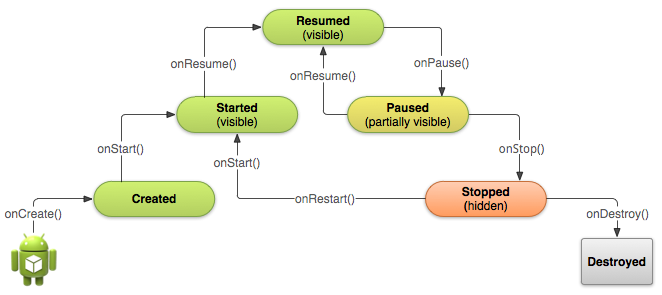編輯:Android編程入門
Intent是不同組件之間相互通訊的紐帶,封裝了不同組件之間通訊的條件。Intent本身是定義為一個類別(Class),一個Intent對象表達一個目的(Goal)或期望(Expectation),敘述其所期望的服務或動作、與動作有關的數據等。Android則根據此Intent對象之敘述,負責配對,找出相配的組件,然後將 Intent對象傳遞給所找到的組件,Android的媒婆任務就完成了。
在Google Doc中是這樣描述Intent的(摘自Android中文翻譯組)
當接收到ContentResolver發出的請求後,內容提供者被激活。而其它三種組件──activity、服務和廣播接收器被一種叫做intent的異步消息所激活。intent是一個保存著消息內容的Intent對 象。對於activity和服務來說,它指明了請求的操作名稱以及作為操作對象的數據的URI和其它一些信息。比如說,它可以承載對一個activity 的請求,讓它為用戶顯示一張圖片,或者讓用戶編輯一些文本。而對於廣播接收器而言,Intent對象指明了聲明的行為。比如,它可以對所有感興趣的對象聲 明照相按鈕被按下。
對於每種組件來說,激活的方法是不同的:
1.通過傳遞一個Intent對象至 Context.startActivity()或Activity.startActivityForResult()以載入(或指定新工作給)一個activity。相應的activity可以通過調用 getIntent() 方法來查看激活它的intent。Android通過調用activity的onNewIntent()方法來傳遞給它繼發的intent。
一個activity經常啟動了下一個。如果它期望它所啟動的那個activity返回一個結果,它會以調用startActivityForResult()來取代startActivity()。比如說,如果它啟動了另外一個activity以使用戶挑選一張照片,它也許想知道哪張照片被選中了。結果將會被封裝在一個Intent對象中,並傳遞給發出調用的activity的onActivityResult() 方法。
2.通過傳遞一個Intent對象至Context.startService()將啟動一個服務(或給予正在運行的服務以一個新的指令)。Android調用服務的onStart()方法並將Intent對象傳遞給它。
與此類似,一個Intent可以被調用組件傳遞給 Context.bindService()以獲取一個正在運行的目標服務的連接。這個服務會經由onBind() 方法的調用獲取這個Intent對象(如果服務尚未啟動,bindService()會先啟動它)。比如說,一個activity可以連接至前述的音樂回放服務,並提供給用戶一個可操作的(用戶界面)以對回放進行控制。這個activity可以調用 bindService() 來建立連接,然後調用服務中定義的對象來影響回放。
3.應用程序可以憑借將Intent對象傳遞給 Context.sendBroadcast() ,Context.sendOrderedBroadcast(), 以及Context.sendStickyBroadcast()和其它類似方法來產生一個廣播。Android會調用所有對此廣播有興趣的廣播接收器的 onReceive()方法將intent傳遞給它們。
Intent對象包含的內容
在Intent類的Java源代碼中定義了Intent相關內容的變量,如下:
[java] view plain copy
1.componentName(組件名稱),指定Intent的目標組件的類名稱。組件名稱是可選的,如果填寫,Intent對象會發送給指定組件名稱的組件,否則也可以通過其他Intent信息定位到適合的組件。組件名稱是個ComponentName類型的對象。
用法:
[java] view plain copy
相當於以下常用方法:
[java] view plain copy
Intent類中也包含一個初始化ComponentName的構造函數:
[java] view plain copy
2.action(動作),指定Intent的執行動作,比如調用撥打電話組件。
[java] view plain copy
3.data(數據),起到表示數據和數據MIME類型的作用。不同的action是和不同的data類型配套的,通過設置data的Uri來獲得。
[java] view plain copy
比如調用撥打電話組件:
[java] view plain copy
4.category(類別),被執行動作的附加信息。例如應用的啟動Activity在intent-filter中設置category。
[xhtml] view plain copy
5.extras(附加信息),為處理Intent組件提供附加的信息。可通過putXX()和getXX()方法存取信息;也可以通過創建Bundle對象,再通過putExtras()和getExtras()方法來存取。
6.flags(標記),指示Android如何啟動目標Activity,設置方法為調用Intent的setFlags方法。常用的Flags參數有:
FLAG_ACTIVITY_CLEAR_TOP
FLAG_ACTIVITY_NEW_TASK
FLAG_ACTIVITY_NO_HISTORY
FLAG_ACTIVITY_SINGLE_TOP
Intent的投遞
1.顯式方式。直接設置目標組件的ComponentName,用於一個應用內部的消息傳遞,比如啟動另一個Activity或者一個services。
通過Intent的setComponent和setClass來制定目標組件的ComponentName。
2.隱式方式。ComponentName為空,用於調用其他應用中的組件。需要包含足夠的信息,這樣系統才能根據這些信息使用intent filter在所有的組件中過濾action、data或者category來匹配目標組件。可參考Android中Activity組件詳解(5.Activity的Intent Filter)
如果Intent指明定了action,則目標組件的IntentFilter的action列表中就必須包含有這個action,否則不能匹配;
如果Intent沒有提供type,系統將從data中得到數據類型。和action一樣,目標組件的數據類型列表中必須包含Intent的數據類型,否則不能匹配;
如果Intent中的數據不是content: 類型的URI,而且Intent也沒有明確指定它的type,將根據Intent中數據的scheme (比如 http: 或者mailto: ) 進行匹配。同上,Intent 的scheme必須出現在目標組件的scheme列表中;
如果Intent指定了一個或多個category,這些類別必須全部出現在組建的類別列表中。比如 Intent中包含了兩個類別:LAUNCHER_CATEGORY 和 ALTERNATIVE_CATEGORY,解析得到的目標組件必須至少包含這兩個類別。
Intent調用常見系統組件
[java] view plain copy
 Android中的Semaphore
Android中的Semaphore
信號量,了解過操作系統的人都知道,信號量是用來做什麼的···在Android中,已經提供了Semaphore來幫助我們使用~那麼
 Android Activity的生命周期簡單總結
Android Activity的生命周期簡單總結
Android Activity的生命周期簡單總結這裡的內容參考官方的文檔,這篇文章的目的不是去總結Activity是如何啟動,如何創造,以及暫停和銷毀的,而是從實際開發
 Android 概述
Android 概述
Android 概述什麼是 Android?Android 是一個開源的,基於 Linux 的移動設備操作系統,如智能手機和平板電腦。Android 是由
 Android 自定義View 三板斧之三——重寫View來實現全新控件
Android 自定義View 三板斧之三——重寫View來實現全新控件
通常情況下,Android實現自定義控件無非三種方式。 Ⅰ、繼承現有控件,對其控件的功能進行拓展。 Ⅱ、將現有控件進行組合,實現功能更加強大控件。 Ⅲ、重寫View